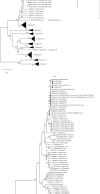Re-Emergence of BTV-4 in Sheep Farms in Kosovo, 2020: A Retrospective Study
- PMID: 40303726
- PMCID: PMC12017115
- DOI: 10.1155/2023/3112126
Re-Emergence of BTV-4 in Sheep Farms in Kosovo, 2020: A Retrospective Study
Abstract
Kosovo has previously seen two bluetongue (BT) epizootics, each caused by a different serotype, BTV-9 in 2001 and BTV-4 in 2014. Since 2014, no clinical cases of BT have been reported in Kosovo. In September, 2020, clinical signs suggestive of BTV infection were observed in several sheep farms in Kosovo. Blood samples from sheep (n = 40) were collected and subjected to further molecular investigations. Molecular analyses confirmed BTV serotype 4 (BTV-4) infection in thirty-six sheep from five different farms across two different regions. Full genome sequence analyses indicated that the BTV-4 strains (KOS2020/01 and KOS2020/02) detected in Kosovo in 2020 had high sequence identity (99.9%-100%) with a strain responsible for an outbreak in North Macedonia in July, 2020, (MKD2020/06) and with previous isolates (≥99.3%) from Greece, Hungary, and France. The percent nucleotide sequence (nt%) identity and phylogenetic analyses suggest that the incursion of BTV-4 into Kosovo was a re-emergence of a previously seen strain and not a novel reassortant. This could be due to a reintroduction of the strain into the region or from subclinical circulation which had been ongoing and underreported for years. Surveillance across Kosovo and the Balkan region to monitor the circulation of BTV is crucial if outbreaks are to be brought under control.
Copyright © 2023 Seyma S. Celina et al.
Conflict of interest statement
The authors declare that they have no conflicts of interest.
Figures



References
MeSH terms
LinkOut - more resources
Full Text Sources
Research Materials

